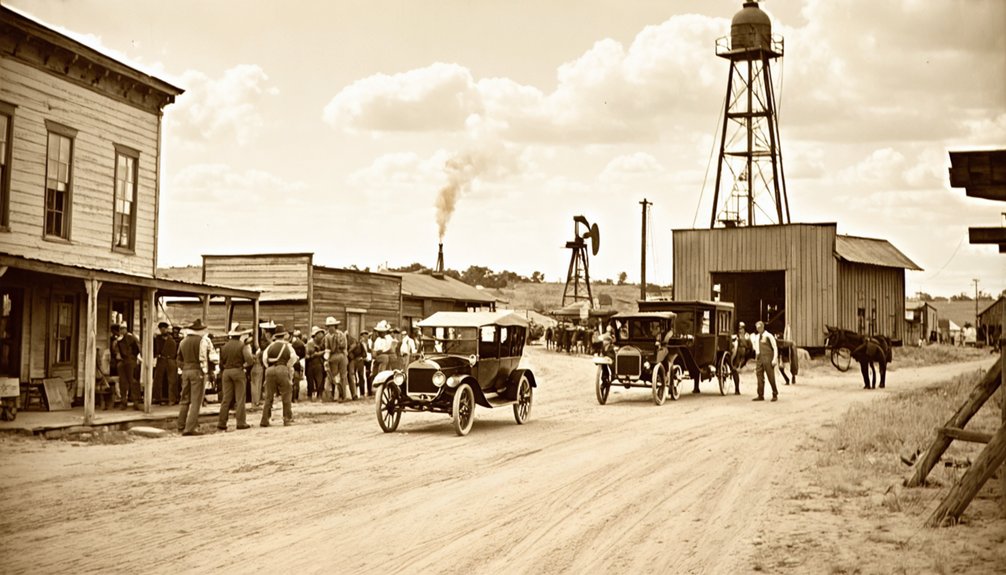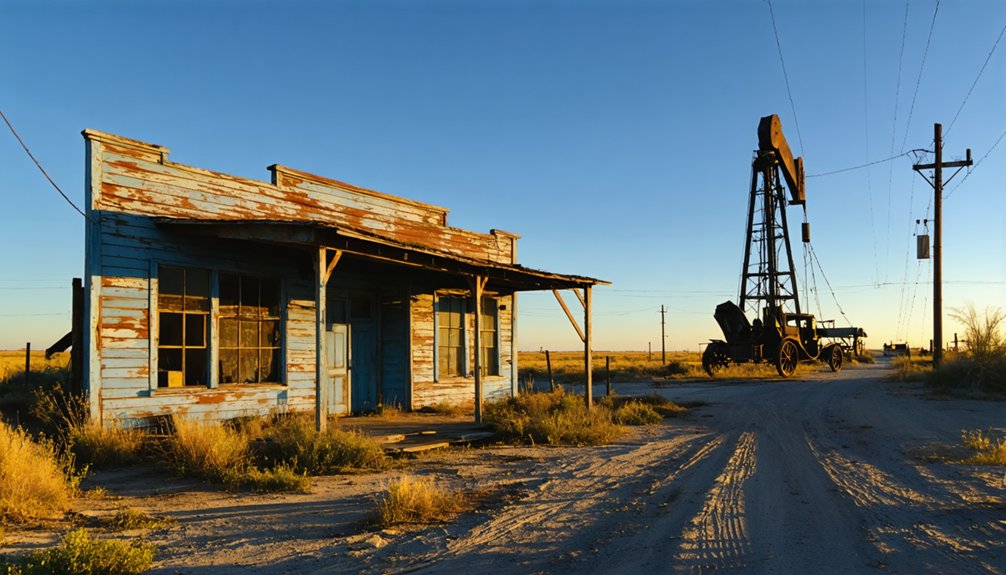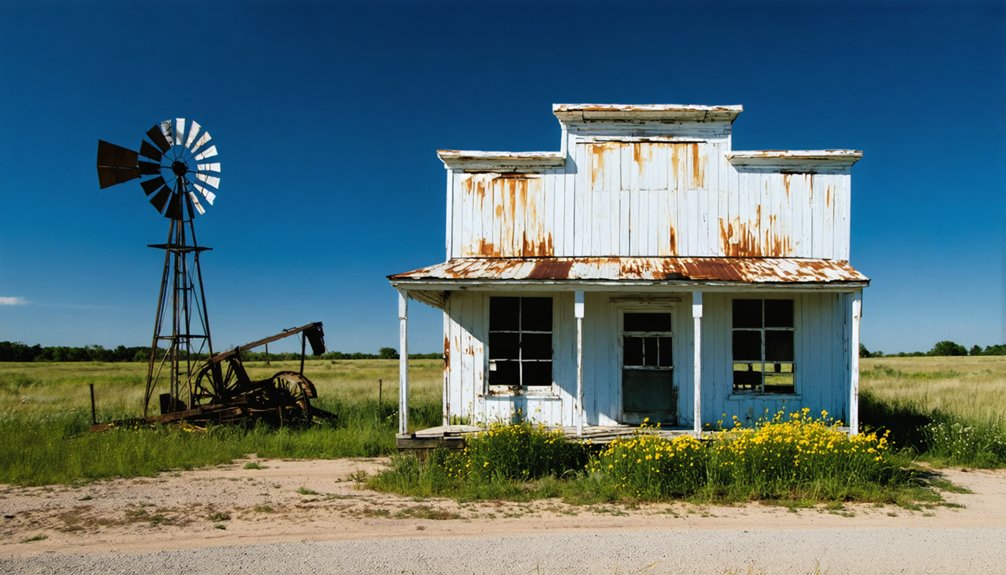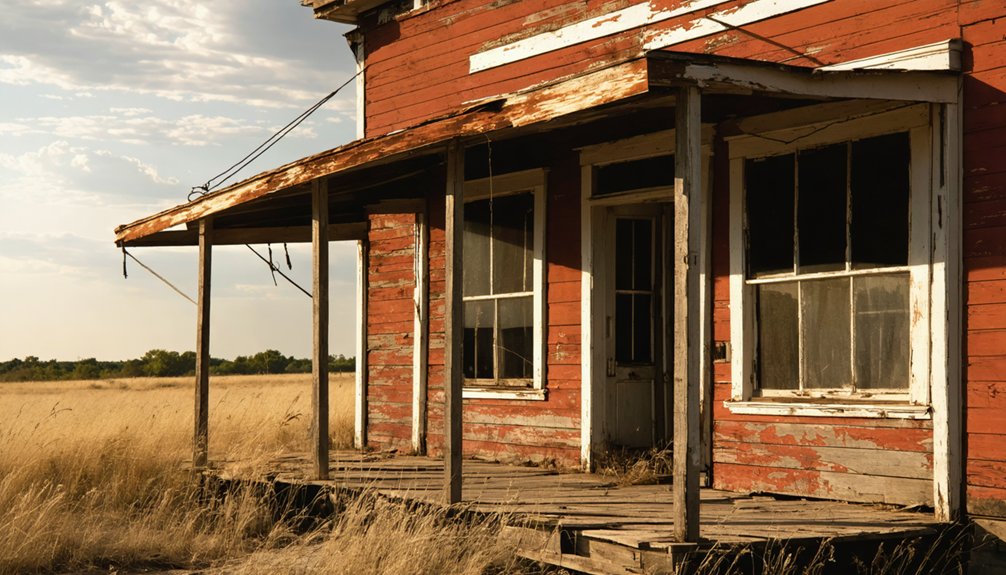You’ll find Eliasville, Texas along the Brazos River, where a once-bustling oil town of 1,500 residents now stands nearly empty. Founded in the 1870s, the town flourished after a 1921 oil discovery, boasting theaters, churches, and the historic Donnell Mill. The mill’s ruins and downtown’s abandoned buildings tell stories of prosperity lost to depleted oil reserves and railway closures. The town’s remaining Gothic Revival architecture and mill remnants hold secrets of its glory days.
Key Takeaways
- Eliasville transformed from a thriving oil boom town of 1,500 residents in the 1920s to a near-ghost town of 100 people by 1980s.
- The town’s decline stemmed from depleted oil reserves, closure of the railroad service, and migration of residents during World War II.
- Historic ruins include the 1879 Donnell Grist Mill, downtown buildings, and a Presbyterian church showcasing Texas Gothic Revival architecture.
- The community lost essential infrastructure through fires, including the mineral spa bathhouse and multiple iterations of the Donnell mill.
- Originally established in the 1870s, Eliasville now stands as a semi-abandoned settlement with limited modern amenities for visitors.
Early Settlement and the Donnell Brothers’ Vision
As settlers pushed into the frontier regions of Texas in the 1870s, Eliasville emerged on land originally owned by J. L. Dobbs.
You’ll find the town’s pioneer resilience reflected in the first cabins built during the 1840s and 1850s, marking the Dobbs Survey as a significant historical landmark.
The Donnell brothers, William and Thomas, shaped early community infrastructure by constructing a grist mill on the Brazos River.
The pioneering Donnell brothers laid Eliasville’s foundation by building their grist mill along the mighty Brazos waters.
They strategically chose a location with sandstone bedrock along the Clear Fork, ensuring a solid foundation.
When disaster struck their first mill, they rebuilt in 1879 with help from a U.S. Government Engineer.
The mill became the economic heart of Eliasville until fire destroyed it in 1927, though its ruins still stand as a symbol of the town’s pioneering spirit. The construction of a steel girder bridge in 1893 further enhanced the town’s infrastructure and accessibility. The town’s first store, owned by Elias DeLong, became the namesake for the settlement when it was officially named in 1878.
From Small Settlement to Thriving Oil Town
While Eliasville existed as a small settlement in the early 1900s, the discovery of oil in 1921 transformed this quiet town into a bustling hub of activity.
Oil exploration brought rapid changes as wells were drilled to depths between 1,350 and 4,250 feet, tapping into rich reserves that would fuel the town’s explosive growth. The town arose in an area once known as Tonk Valley, historically home to Tonkawa tribes.
The community impact was immediate and far-reaching. The town’s prosperity would be short-lived, as multiple fires severely damaged local businesses and infrastructure.
You’d have seen the Wichita Falls & Southern Railroad extending its reach to connect Eliasville with Graham and South Bend, creating essential transportation links for the oil industry.
The town soon boasted its own water system, multiple bridges, hotels, and casinghead gasoline plants.
Nelson’s Drug Store, churches, schools, and even gambling halls sprung up to serve the growing population of oil workers and their families.
The Rise and Fall of Donnell Mill
You’ll find the story of Donnell Mill at the heart of Eliasville’s transformation, where the Donnell brothers constructed their grist mill on a sandstone foundation along the Brazos River before 1879.
The mill, rebuilt that same year with help from a U.S. Government Engineer, became an essential trade hub for local grain producers and served as the community’s economic anchor for decades.
A suspension bridge near the mill site helped connect the growing communities on both sides of the river.
A vibrant Fort Griffin community relied on the mill to grind their flour and meal.
Your glimpse into this era would end in 1927 when fire destroyed the mill, leaving only ruins that still stand today as a memorial to Eliasville’s industrial past.
Historic Mill Construction
During the late 19th century, the Donnell brothers, William and Thomas, established an essential grist mill on the western banks of the Brazos River in Eliasville, Texas. The mill’s architecture featured a robust foundation built directly on sandstone bedrock, showcasing the brothers’ resourceful use of local materials in their construction.
After a devastating fire destroyed the original structure, they rebuilt the mill in 1879 with help from a U.S. Government Engineer. The improved design included a low-water dam on the Brazos and demonstrated advanced engineering techniques. By 1937, the mill site had become a popular spot for families and swimmers seeking recreation.
Near the mill, the Donnells constructed a suspension bridge to enhance transportation access, which was later replaced by larger bridges in 1893. This combination of mill and bridge infrastructure transformed Eliasville into a crucial economic hub.
Regional Trade Hub
As the cornerstone of Eliasville‘s economic importance, the Donnell Mill transformed this Texas town into a bustling regional trade hub throughout the late 19th century.
You’ll find the mill’s strategic location along the Brazos River, coupled with its essential suspension bridge, created perfect trade dynamics for local farmers and merchants.
The mill’s influence extended beyond grain processing, attracting businesses and establishing Eliasville as a significant market center.
Three bridges and the Chicago Rock Island & Pacific Railroad connection strengthened the town’s position in regional commerce.
However, economic shifts began with devastating fires in 1927, followed by depleting oil reserves and the railroad’s departure in the 1960s. The W. L. Donnell family, who established their ranches in 1876, played a pivotal role in the mill’s early success.
These changes marked the end of Donnell Mill’s reign as the area’s commercial powerhouse, though its impact on Texas trade history remains remarkable.
1927 Fire Destruction
The dramatic story of Donnell Mill’s destruction began with a lightning strike that devastated the original structure built by William and Thomas Donnell in the late 19th century.
After the fire aftermath, they rebuilt the mill in 1879 with help from a U.S. Government Engineer, demonstrating their determination to maintain this essential hub of commerce along the Brazos River.
The mill restoration proved successful until 1927 when another catastrophic fire destroyed the facility for the final time.
Though W.A. Andrews continued operations into the 1930s, the repeated fires had taken their toll.
The property changed hands several times, eventually landing with Mr. Stroud of Eliasville.
Today, you’ll find only ruins of the once-prosperous mill and dam, serving as a haunting reminder of Eliasville’s industrial heritage.
Life During the Peak Years: 1920s Eliasville

Life in 1920s Eliasville bustled with remarkable energy when oil discoveries transformed this quiet mill town into a thriving community of 1,500 residents.
You’d find yourself surrounded by the sights and sounds of a booming Texas town, where community events centered around multiple churches and two movie theaters. Social gatherings ranged from family-friendly activities at the local school to late-night entertainment at gambling halls. The town gained official status when it was incorporated in 1921.
By the 1980s, the once-prosperous town had experienced a dramatic shift, with population dwindling to 100 residents.
The town’s infrastructure served both locals and visitors well, with three gas stations, a water system, and multiple bridges crossing the Brazos River.
You could stay at the hotel, shop at various stores, or watch workers produce casing head gasoline at local facilities. The historic Donnell Mill, established in 1879, continued operating alongside the new oil operations that defined this vibrant era.
Transportation Networks and Economic Impact
Through essential railroad connections and strategic roadways, Eliasville’s transportation networks played a significant role in shaping its economic destiny during the early 20th century.
You’ll find the Chicago Rock Island & Pacific Railroad’s legacy deeply woven into the town’s transportation history, providing essential freight and passenger services that fueled local growth.
When oil boomed in the 1920s, these rail connections proved critical for moving petroleum products to market. The Donnell grist mill’s success also depended heavily on these transport links.
Rail transport transformed Eliasville’s economy, enabling both the oil industry’s success and the Donnell mill’s vital operations in the 1920s.
As rail service declined in the 1960s, the town’s economic changes became increasingly challenging. While farm roads like FM 1974 and FM 3109 still connect Eliasville to neighboring communities today, they haven’t matched the economic impact that rail transport once delivered.
The Slow Decline of a Once-Bustling Community

You’ll find Eliasville’s decline rooted in the depletion of its two main economic pillars: the dwindling oil production that began in the 1930s and the modernization of agriculture that eliminated numerous farm jobs.
The town’s population plummeted from 1,500 during the 1921 oil boom to just 400 by 1940, as residents left for defense industry positions in Fort Worth and other urban centers.
The loss of essential infrastructure through fires, including the historic Donnell grist mill in 1927 and the mineral spa bathhouse in 1994, further accelerated the community’s transformation into a semi-abandoned settlement.
Dwindling Resources Impact
As multiple key industries began to falter in Eliasville, the town’s economic foundations crumbled beneath mounting pressures.
You’ll find that resource scarcity hit the community hard – first with depleted oil reserves, then the flour mill’s decline. The town’s economic vulnerability became apparent as no new industries stepped in to fill the void.
The closing of the railroad service in the late 1960s dealt another devastating blow.
You can still see evidence of this decline today in the abandoned buildings and lost infrastructure, including the vanished pedestrian bridge over the Brazos River. The town’s young workforce left for urban opportunities, while remaining residents watched their tax base shrink.
With each closing business and failing service, Eliasville’s ability to sustain itself diminished, creating a cycle of deterioration that proved impossible to break.
Population Exodus Patterns
When Eliasville reached its peak population of 1,500 during the 1920s oil boom, few could have predicted its dramatic descent into a ghost town.
You’ll find that the population trends followed a distinct pattern of decline, starting with a sharp drop to 400 residents by 1940. World War II accelerated this exodus as locals sought defense-related jobs in Fort Worth and beyond.
The economic shifts continued to drive people away through the following decades. As oil production waned and agriculture became increasingly mechanized, you’d see fewer workers needed in both industries.
Architectural Legacy and Historic Remnants
The architectural heritage of Eliasville, Texas tells a compelling story through its remaining structures and ruins.
You’ll find the most significant historic remnant at the Donnell Grist Mill, established in 1879 by William Leander and Thomas Franklin Donnell. Its stone foundations stand as a symbol to late 1800s industrial architecture, marking the town’s agricultural roots until it burned in 1927.
Downtown’s scattered ruins reveal Eliasville’s evolution from Elias DeLong’s 1878 store through the oil boom years.
The Presbyterian church, organized in 1881, showcases typical rural Texas Gothic Revival design. You can still spot fragments of historic tin ceiling tiles among commercial building remains, while abandoned railroad beds and bridge foundations trace the transportation network that once connected this now-quiet town to the wider world.
Visiting the Ghost Town Today

Visiting Eliasville today requires careful planning and self-reliance, as this north-central Texas ghost town offers no modern amenities or visitor facilities.
You’ll need to drive your own vehicle along rural roads to reach this historic site along the Brazos River, where ghost town exploration reveals the remnants of a once-bustling oil boomtown.
For successful historical photography and exploration:
- Pack essential supplies, as nearest services are miles away
- Wear sturdy boots to safely navigate unstable ruins and debris
- Bring cameras to capture the Donner Mill and downtown ruins
- Research the site’s history beforehand, as no guides are available
While exploring the deteriorated structures and bridges, you’re free to photograph and observe, but remember to respect private property boundaries and leave artifacts undisturbed for future visitors to discover.
Frequently Asked Questions
Are There Any Documented Paranormal Activities or Ghost Sightings in Eliasville?
You won’t find officially documented ghost stories or haunted locations in Eliasville itself, though nearby ghost towns like Helena and Oakville report paranormal activity that may influence local legends.
What Happened to the Town’s Original Cemetery and Burial Records?
While 82% of nearby Peveler Cemetery is photographed, you’ll find incomplete documentation for Eliasville’s original cemetery. No cemetery relocation occurred, but many burial records were lost during the town’s decline.
Did Any Famous Outlaws or Historical Figures Visit Eliasville?
You won’t find any confirmed outlaw legends or famous historical visitors in Eliasville’s records. The town’s history centers on ranching pioneers, mill operations, and the 1920s oil boom instead.
What Native Tribes Originally Inhabited the Area Before Settlement?
Like an ancient GPS map, you’d find the Caddo nation dominated this land first, while Tonkawa, Comanche, and Kiowa tribes later controlled the territory through prehistoric settlements near the Trinity River.
Are There Any Active Preservation Efforts to Protect Eliasville’s Remaining Structures?
You won’t find official preservation initiatives protecting Eliasville’s remaining structures. Local historians and community groups informally document historical landmarks, but there’s no funded program or dedicated organization managing active preservation efforts.
References
- https://www.redriverhistorian.com/post/milling-around-eliasville
- https://www.ghosttowns.com/states/tx/eliasville.html
- https://en.wikipedia.org/wiki/List_of_ghost_towns_in_Texas
- https://www.allacrosstexas.com/texas-ghost-town.php?city=Eliasville
- http://fortworthgazette.blogspot.com/2011/04/ghost-towns-on-brazos-shades-of.html
- https://www.youtube.com/watch?v=1j5voBV4HCc
- https://www.texasescapes.com/TexasTowns/Eliasville-Texas.htm
- https://www.breckenridgeamerican.com/opinion/impact-cunningham-family
- https://jeffersoncountytx.gov/historical_commission/files/History/Jefferson_County_History_2015-12-03.pdf
- https://en.wikipedia.org/wiki/Eliasville



